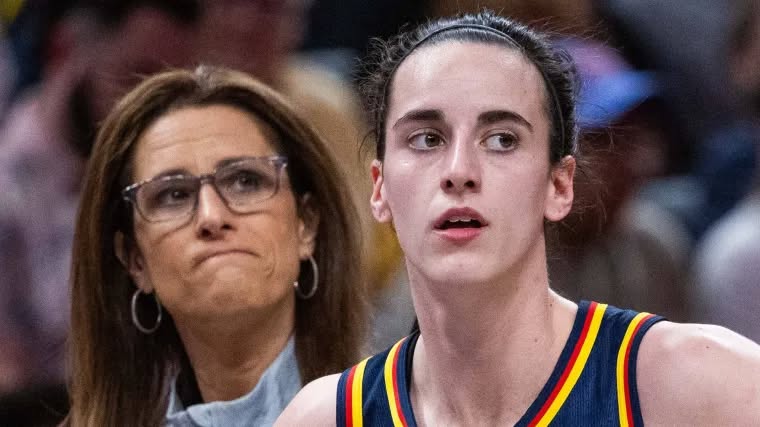Caitlin Clark, the electrifying rookie who took college basketball by storm, is facing her first real challenge in the WNBA. After a historic NCAA career that saw her shatter records and captivate audiences, Clark’s transition to the professional league hasn’t been seamless. Through her first few games with the Indiana Fever, the No. 1 overall pick has shown flashes of brilliance but has also struggled with consistency, facing tighter defenses, physical play, and the inevitable learning curve of adjusting to the WNBA’s speed and intensity.
Recognizing the need to unlock Clark’s full potential, Indiana Fever head coach Stephanie White has unveiled a detailed game plan designed to help the young phenom break out of her early-season slump. In an exclusive interview, White outlined the strategies the Fever are implementing to ensure Clark finds her rhythm and becomes the franchise cornerstone they drafted her to be.
Before diving into the solutions, it’s important to diagnose the root of Clark’s struggles. In her first handful of WNBA games, Clark has faced relentless defensive pressure. Opposing teams, well aware of her scoring prowess, have thrown double teams, physical defenders, and aggressive close-outs to disrupt her rhythm. Additionally, the pace of the WNBA game is faster, with shorter shot clocks and more disciplined defensive schemes than what she faced in college.
Statistically, Clark’s numbers haven’t been disastrous—she’s still averaging double-digit points and leading the team in assists—but her shooting efficiency has dipped. Her three-point percentage, a hallmark of her game at Iowa, has been inconsistent, and turnovers have been an issue as she adjusts to the speed of pro defenses.
Coach White acknowledges these challenges but remains confident in Clark’s ability to adapt. “Caitlin is one of the most competitive players I’ve ever been around,” White said. “She’s a student of the game, and she’s already making adjustments. Our job is to put her in the best position to succeed.”
1. **Simplifying the Offense**
One of the key adjustments White has implemented is streamlining the offensive sets to reduce decision-making pressure on Clark. In college, Clark often had the freedom to create off the dribble and launch from deep at will. In the WNBA, defenses are quicker to react, and help-side rotations are more precise.
To counter this, the Fever are running more structured actions to get Clark open looks. This includes using more off-ball screens to free her for catch-and-shoot opportunities, as well as staggered pick-and-roll sets to give her cleaner driving lanes. “We don’t want her overthinking,” White explained. “We’re giving her clearer reads so she can play instinctively.”
2. **Increasing Off-Ball Movement**
A major point of emphasis has been getting Clark more involved when she doesn’t have the ball in her hands. At Iowa, she was the primary ball-handler on nearly every possession, but in the WNBA, teams are keying in on her as soon as she crosses half-court. To prevent defenses from loading up on her, the Fever are incorporating more motion into their offense, using Clark as a decoy at times to create open shots for teammates before quickly relocating her for open looks.
“We’re teaching her how to play without the ball more,” White said. “She’s learning how to use screens away from the action to get open, and that’s going to make her even more dangerous.”
3. **Adjusting to Physicality**
The WNBA is far more physical than college basketball, and Clark has had to adjust to defenders being allowed to body her more on drives and contest her shots more aggressively. White has been working with Clark on improving her strength and balance through contact, as well as refining her footwork to create separation.
“She’s getting bumped more, and the refs aren’t going to bail her out every time,” White noted. “We’re doing a lot of drills where she has to finish through contact, and she’s responding well. Once she gets more comfortable with the physicality, her efficiency will go up.”
4. **Encouraging Aggressiveness**
Despite her early struggles, White doesn’t want Clark to lose confidence in her shot. One of the biggest messages from the coaching staff has been to keep shooting, even if a few misses pile up. “The worst thing she can do is hesitate,” White said. “We want her to stay aggressive because that’s when she’s at her best.”
To reinforce this, the Fever are designing plays specifically to get Clark going early in games. Whether it’s a quick flare screen for a three or an early post-up against a smaller guard, the goal is to help her find a rhythm before defenses can settle in.
5. **Film Study and Mentorship**
Beyond on-court adjustments, White has emphasized the importance of film study. Clark has been spending extra time breaking down game footage, studying how elite WNBA guards like Diana Taurasi and Sue Bird navigate defenses and create their own shots.
Additionally, the Fever’s veterans—including Kelsey Mitchell and Erica Wheeler—have taken Clark under their wing, offering advice on managing the grind of the WNBA season and dealing with the mental toll of early struggles. “The veterans have been huge for her,” White said. “They’ve been through it, and they’re helping her understand that every great player goes through an adjustment period.”
### **The Long-Term Vision**
While the immediate focus is on helping Clark break out of her slump, White is also keeping an eye on the bigger picture. The Fever didn’t draft Clark just for this season—they see her as the centerpiece of a championship-contending team in the years to come.
“This is a process,” White said. “Caitlin is going to have ups and downs, but we’re building something special here. Every game, she’s learning, and every practice, she’s getting better. By the end of the season, people are going to see a much more polished player.”
### **Conclusion**
Caitlin Clark’s first WNBA slump was inevitable. Every rookie, no matter how talented, faces growing pains when transitioning to the professional level. What separates the good from the great is how they respond—and with Stephanie White’s guidance, the Fever are putting Clark in the best possible position to thrive.
By simplifying the offense, increasing her off-ball movement, helping her adjust to physicality, and reinforcing her confidence, Indiana is laying the groundwork for Clark’s breakout. It may take a few more games, but when it clicks—and it will—the league should be on notice.
As White put it: “Caitlin Clark is too talented, too driven, and too competitive to stay in a slump for long. Once she puts it all together, she’s going to take this league by storm.”
For the Indiana Fever and their fans, that moment can’t come soon enough.



